You are here : Home City of energies > HOME BIAM > Search > LEMIRE > LEMIRE research themes and projects
Research topics
Plants have co-evolved with their microbiota for more than 300 million years. The whole genome of this microbiota (microbiome) is an extension of the host plant genome (holobiont). The interactions between the host and its microbiota rely on sophisticated ways to communicate and coexist. Complex, interconnected networks of signals and metabolites modulate the plant-microbiota and microbe-microbe communication pathways to regulate these interactions.
Our research activities are devoted to the study of soil-plant-microbiota interactions, with a particular focus on the role of host-associated microbiota in mediating interactions between the host and its biotic/abiotic environment and the adaptive strategies of bacteria to their host plant and environment.
The soil-plant-microorganisms interaction in the rhizosphere is a key process that plays a key role in plant growth and health and carbon recycling/storage

Interaction Sol-colza-Rhizobium alamii exopolysaccharides (Santaella et al., EMi 2008).
1.1 The microbiota mediates interactions between the host and its environment
The plant microbiota plays a key role in plant growth and health. The structure and functions of this microbiota are modulated by the host and the environment. In feedback, the microbiota mediates interactions between the host and the environment.
Our research aims to study the interactions between the host, the microbiota and the abiotic environment in the context of anthropogenic pollution, such as metals (DUNE, PRIMARy) and nanomaterials, and the improvement of plant (ENHANCE, InSTep) and forest (RESTORE) health. https://www.biodiversa.org/1874/download).
Nanotechnologies are a major source of cutting-edge materials that can help the necessary transformation of agriculture in a context of environmental transition, and preservation of resources and the environment (adaptation to climate change, reforestation, reduction in the use of pesticides, etc.).
In the framework of the SERENADE LabEX (Ecodesign Research and Education applied to Nanomaterials, 2012-2020), microbiota from terrestrial and aquatic environments have been used as a tool to improve the knowledge of structure-intrinsic properties/environmental implications of nanomaterials (MEANTime) and to design “safer-by-design” nanomaterials (Safer-by-Design).
Our research aims at understanding how the properties of nanomaterials modulate their interactions with the plant-soil-microbiota system (ANALOGY), allowing the development of nanotechnologies for agriculture (InSTep) and reforestation (RESTORE) through a Safer-by-Design approach.
Our approach integrates the study of social representations of nanomaterials by professionals in agriculture and forest management (RESO-Nano) in partnership with Alexandra Schleyer-Lindenmann and Nelly Pares of the UMR ESPACE (Étude des Structures, des Processus d’Adaptation et des Changements de l’Espace).
1.2 Plant-microbiota molecular dialogue
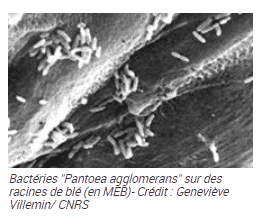
In the framework of RootAdapt “Root traits for adaptation of pearl millet to future climate in West Africa“, we aim to identify the assemblage and ecological network of the most influenced microbial populations by the changes in different pearl millet inbred lines exudation and the correlation between these populations with specific metabolic pathways related to diversity of molecules exuded by the roots.
A better understanding of how the plant responds to phytopathogens versus phytobeneficial bacteria and how the latter potentiate the plant’s defense response to control diseases is addressed by a RNA-Seq approach.
The LEMiRE team has gained experience in exploiting the potential of microbial diversity for sustainable solutions in crop protection against disease and pests in the frame of projects developed with private companies :
- Micro-organisms for Sustainable Agriculture (MOPAD). Biological control agents based on microorganisms to protect common wheat against Fusarium head blight.
- Use of microbial diversity to identify insecticidal activities against the larva of the corn rootworm Diabrotica virgifera virgifera (DIETETIC). Bacterial genomes sequencing and exploration for in silico screening of insecticidal molecules against corn Diabrotica larvae.
Our work aims to study the mechanisms of adaptation to environmental constraints of two bacterial models that represent different modalities of tolerance to stresses related to their habitats.
2-1 Adaptative strategies of phytobeneficial bacteria
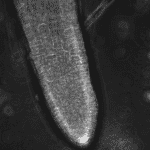
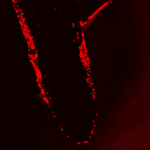
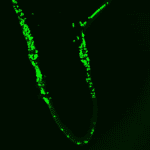
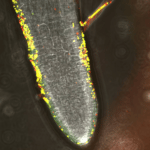
We investigate the role of non-coding regulatory RNAs and extramembrane vesicles in the interaction of Pseudomonas brassicacearum with plants and other microorganisms and in response to environmental stresses.
We would like to explore how plants differentiate phytobeneficial bacteria from pathogens.
We explore 1800 phytobeneficial bacterial genomes. These genomes have been sequenced in the framework of the MOPAD and DIETETIC projects and are currently being explored and exploited with the Microscope tool of the Genoscope in which they are housed.
2-2 Adaptative strategies of Ramlibacter tataouinensis to extreme environments
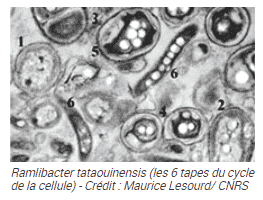
This desert bacterium has the particularity to alter orthopyroxene, a major constituent of meteorites. The high tolerance of this bacterium to extreme desert conditions, and in particular to desiccation, is probably linked to the original cell cycle characterized by the coexistence of coccoid cells surrounded by a protective polymer (presenting all the characteristics of a cyst resistant to desiccation: Ø 0.8 µm) and rod-like cells (Ø 0.2 x 3 µm). The mobility of the rods ensures the dissemination of the population allowing the colonization of new ecological niches. Exploration of the R. tataouinensis genome and experimental evidence suggest the involvement of light via its two bacteiophytochromes and the circadian cycle regulator KaiC in the control of the cell cycle of this bacterium.
Projects with industrials
- Structuring Research and Development Projects for Competitiveness (PSPC) of the Future Investment Program (PIA2). BpiFrance funding: Project title: “Micro-Organisms for Sustainable Agriculture” “Selection of bacterial strains antagonistic to fusariosis in wheat” (MOPAD) (2014-2018). Partners: Limagrain, Biovitis, CEA/CNRS (LEMiRE, IG Genoscope Evry).
- AAP du Groupement National Interprofessionnel des Semences et plants (GNIS) sur Diabrotica (2016-2019). Project title: “Use of microbial DIversity to idenTify insEcTICidal activities against the corn rootworm larva (Diabrotica virgifera virgifera)” (DIETETIC). Partners: Biogemma, Proteus, CEA/CNRS (LEMiRE, IG Genoscope, Evry).
- Ecofriendly Hybrid Nanos pesticides (ENHaNCE), LabEX SERENADE (2019-2020). Partners : LEMiRE, BIA -INRAE, CEREGE.
- MEta-Analysis of NanomaTerial environmental Impact on Microbiota (MEANTIMe), LabEX SERENADE (2019-2020). Partners : LEMiRE, CEREGE.
Theses
Sarah Wagon (2022-)
“ Stimulating the plant-microorganism-mineral continuum to store carbon in soils: focus on rhizodeposit stabilization”.
Supervision: T. Heulin Co- Supervision E. Doelsch (CIRAD, CEREGE),
ITEM d’AMIDEX.
Aix-Marseille Université.
Tom Girard (2021-)
“ Stimulating the plant-microorganism-mineral continuum to store carbon in soils: focus on biotic alteration of minerals”.
Supervision : Isabelle Basile-Doelsch (INRAE, CEREGE) Co- Supervision : W. Achouak.
ITEM d’AMIDEX. Aix-Marseille University
Anaïs Blache (2021-)
“Contribution of outer membrane vesicles in Pseudomonas brassicacearum-plant hostinteraction ”.
Supervision : W. Achouak.
Aix-Marseille University
- MACIAS PEREZ Luis Alberto
“CREBEX Critical Raw Element Bio-extraction”DOC2AMU COFUND program Aix-Marseille University. Co-Direction : M. AUFFAN/C. LEVARD/W. ACHOUAK
- TULUMELLO Joris
“In silico search for bacterial gene clusters involved in exopolysaccharide production”Aix-Marseille University CIFRE agreement (Biointrant company)
Direction T. HEULIN.
Philippe Ortet (IR CEA)
“ From automatic genome annotation to expert annotation for environmental genomics ”
Aix-Marseille University
Supervision : Heulin T
Thesis defended September 25 2018
- SELMANI Zakia (2014-)
“Microbial diversity in the dunes of the Grand Erg Occidental (Algeria)” (Directeur de thèse : T. HEULIN Co-directeurs : Y. KACI et W. ACHOUAK).Bab Zouar University, Alger Funding : PHC Tassili
Defense scheduled in 2021
- BEHAIRI Sabrina (2017-)
“Diversity of halotolerant bacteria in the rhizosphere of halophilic plants (Chott Melghir, Algeria)”Bab Zouar University, Alger. (Directeur de thèse : Y. KACI Co-directeurs : T. HEULIN et W. ACHOUAK).
Defense scheduled in 2021
- EL ALAOUI Abdelkhalek
“Study of the role of bacteria-plant symbioses in the depollution of soils contaminated by heavy metals”
Thesis in cotutelle.Cadi Ayyad University Marrakech & Aix-Marseille University (2019)
Defended on Decembre 21, 2018– Co-Direction K. OUFDOU/B. IMZILN/W. ACHOUAK
- DZUMEDZEY Yulia
“Mobility of manufactured nanoparticles within a natural organic gel”. Thèse de Doctorat, Formation Doctorale : Science de l’Environnement.Aix-Marseille University
Defended on June 13, 2017 – Co-Direction J. LABILLE/C. SANTAELLA
- JIVKOVA Desislava
“Characterization of the structure and properties of the exopolymer of Ramlibacter tataouinensis”. Funding : convention CIFRE (ARD company).Aix-Marseille University
Defended on July, 2018 – Direction T. HEULIN
- HAMIDAT Mohamed
“Relationship between the eco-design of nanomaterials embedded in paints and other surface treatments and their biotransformation in a terrestrial ecosystem”.Aix-Marseille University
Defended on Decembre 8, 2015 – Direction C. SANTAELLA
- HARFOUCHE Lamia
“Characterisation of two novel regulatory non-coding RNAs involved in iron metabolism in Pseudomonas brassicacearum“
Aix-Marseille UniversityDefended on September 26, 2014 – Direction W. ACHOUAK
- LALAOUNA David
“Role of regulatory non-coding RNAs in Pseudomonas brassicacearum adaptation to the rhizosphere and to environmental fluctuations”Aix-Marseille University
Defended on March 9, 2012 – Direction W. ACHOUAK
- CHABERT Nicolas
“Microbial fuel cells optimization of biocathodes”Aix-Marseille University.
Defended on Decembre 2, 2017 – Direction W. ACHOUAK
- NDOUR Papa Mamadou Sitor
“Phenotyping of millet lines on their ability to induce root adherent soil formation”Cheikh Anta Diop University Dakar (Senegal).
Defended on Decembre 22, 2017 – Co-Direction L . COURNAC/T. HEULIN
- BENIDIRE Loubna
“Role of symbiotic bacteria in improving crop production of Vicia faba L. under salt stress.”Kadi AYYAD University Marrakech
Defended on July 4, 2017– Co-Direction K. OUFDOU/M. GOTTFERT/W. ACHOUAK
- LAVEILHE Arnaud
“Impact of molecular dialogue between bacteria and between plants and bacteria on the expression of phytobeneficial genes”Aix-Marseille University.
Defended on October 20, 2017 – Direction T. HEULIN
- LAYET Clément
“ Phyto-availability of nanomaterials and impact on trace metal removal”. Formation Doctorale Sciences de l’EnvironnementAix-Marseille University
Defended on Decembre 17, 2017- Co-Direction E. DOELSH/C. SANTAELLA
- EL KHALLOUFI Fatima
“Cyanotoxin-induced phytotoxicity: Impact of irrigation water contamination on bacteria associated with the rhizosphere of Medicago truncatula”
Kadi AYYAD University MarrakechDefended on October 6, 2012 – Co-Direction B. OUDRA/K. OUFDOU/W. ACHOUAK
- DULERMO Rémi
“Investigating the mechanisms of extreme radiation tolerance in the bacterium Deinococcus deserti using a functional genomics approach”
Aix-Marseille University
Defended on Decembre 15, 2009 – Direction A. de GROOT
- BRESSAN Mélanie
“Effects of root exudates from a Brassicaceae plant on rhizospheric microorganisms: influence of exogenous glucosinolate production in Arabidopsis thaliana. Use of a DNA isotope tracing approach (DNA-SIP)”Aix-Marseille University
Defended on April 7, 2009 – Direction O. BERGE / W. ACHOUAK
- HAICHAR Feth-el-Zahar
“Impact of root exudates in taxa selection and bacterial functions in the rhizosphere”Aix-Marseille University
Defended on May 20, 2008 – Direction W. ACHOUAK
- PROFIZI Camille
“New elicitors isolated from a rhizospheric bacterium for the protection and health of plants” Funding : CIFRE agreement (ARD company).Aix-Marseille University
Defended on July 13, 2007 – Direction C. SANTAELLA
Team manager
Wafa ACHOUAK
Key words
Rhizosphere ; Pseudomonas ; Biointrants ; Genomics ; Nanopesticides ; Biocontrol ; drought stress ; Outer membrane ; vesicles ; Regulatory RNAs